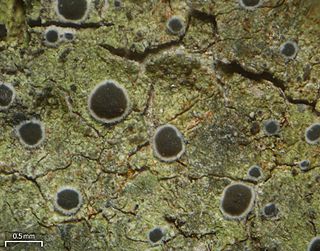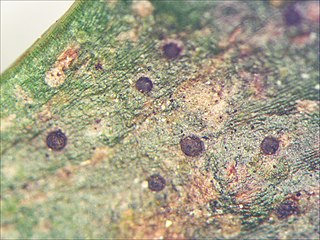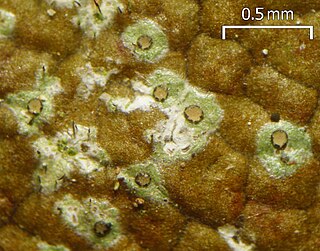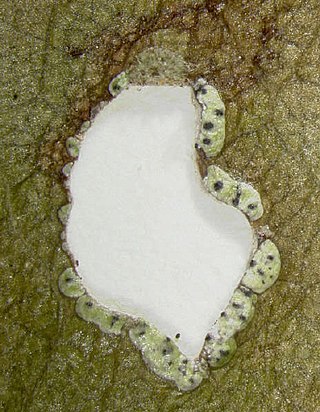
The Pilocarpaceae are a family of crustose lichens in the order Lecanorales. The species of this family have a cosmopolitan distribution and have been found in a variety of climatic regions. Pilocarpaceae was circumscribed by Alexander Zahlbruckner in Adolf Engler's influential 1905 work Die Natürlichen Pflanzenfamilien.

Bacidina is a genus of lichens in the family Ramalinaceae. It was circumscribed by Czech lichenologist Antonín Vězda in 1990, with Bacidina phacodes assigned as the type species. Vězda included 11 species in Bacidina, which was originally classified in the Lecideaceae. These species had previously been placed in genus Bacidia.

Porina is a genus of lichens in the family Trichotheliaceae. A 2020 estimate places about 145 species in the widespread genus.
Lasioloma is a genus of lichenized fungi in the family Pilocarpaceae. The genus was circumscribed by Swedish lichenologist Rolf Santesson in 1952, with Lasioloma arachnoideum assigned as the type species. Found predominantly in tropical rainforests, genus Lasioloma contains both foliicolous (leaf-dwelling) and corticolous (bark-dwelling) species. The foliicolous species are distinguished by their woolly prothallus, a thallus that ranges from dispersed to continuous, and a hairy apothecial margin. In contrast, corticolous species typically do not have a woolly prothallus, and their thalli are usually continuous, or unbroken. Regardless of the substrate they inhabit, all known Lasioloma species are characterized by the production of campylidia and branched conidia.

Calopadia is a genus of foliicolous (leaf-dwelling) lichens in the family Pilocarpaceae. It was circumscribed by Czech lichenologist Antonín Vězda in 1986.
Badimia is a genus of foliicolous (leaf-inhabiting) lichens in the family Ramalinaceae.

Tapellaria is a genus of leaf-dwelling lichens in the family Pilocarpaceae. The genus was circumscribed by lichenologist Johannes Müller Argoviensis in 1890, with Tapellaria herpetospora assigned as the type species.
Sporopodium is a genus of lichen-forming fungi in the family Pilocarpaceae.

Micarea is a genus of lichenized fungi in the family Pilocarpaceae. The widely distributed genus contains 126 species and new species are described actively. Species in the genus are crustose lichens and their photobiont is a single-celled green alga.

Mazosia is a genus of lichen-forming fungi in the family Roccellaceae. The genus was circumscribed by Italian lichenologist Abramo Bartolommeo Massalongo in 1854.
Echinoplaca is a genus of lichens in the family Gomphillaceae.
Gyalectidium is a genus of lichen-forming fungi in the family Gomphillaceae. A 2020 estimates placed 52 species in the genus. The genus was circumscribed by Swiss lichenologist Johannes Müller Argoviensis in 1881. He included 3 species: G. xantholeucum, G. dispersum, and G. filicinum; the last of these is now the type species of the genus.

Tricharia is a genus of lichens in the family Gomphillaceae. It has an estimated 30 species.

Malmidea is a genus of crustose lichens and the type genus of the family Malmideaceae. It was established in 2011 to contain a phylogenetically distinct group of species formerly placed in the genus Malcolmiella. The crust-like thallus of Malmidea lichens has a surface that varies from smooth to rough, featuring textures such as verrucose (wart-like), granulose (grainy), or pustulate (pimpled). These textures are often formed by goniocysts, which are spherical clusters of green algal cells from the family Chlorococcaceae, encased in fungal hyphae. Malmidea comprises nearly 70 mostly tropical species that grow on bark, although a few grow on leaves.

Strigula is a genus of lichen-forming fungi in the family Strigulaceae. The genus was circumscribed in 1823 by English mycologist Elias Magnus Fries.

Coenogonium is a genus of filamentous lichens in the monotypic family Coenogoniaceae. It has about 90 species. Most species are leaf-dwelling or grow on bark, although a few are known to grow on rocks under certain conditions, and some are restricted to growth on termite nests. The genus was circumscribed in 1820 by German naturalist Christian Gottfried Ehrenberg.
Eugeniella is a genus of mostly leaf-dwelling (foliicolous) lichens in the family Pilocarpaceae. It contains 13 species. The genus was circumscribed in 2008 by lichenologists Robert Lücking, Emmanuël Sérusiaux, and Klaus Kalb, with Eugeniella psychotriae assigned as the type species. This lichen was originally called Patellaria psychotriae by Johannes Müller Argoviensis in 1881. The seven species that were initially included in the genus had previously been placed in the genera Bacidia and Byssoloma. Several newly identified species from Australasia and Central and South America were later added. Most of the species grow on leaves, although four of the Australasian species grow on bark.
Brasilicia is a genus of leaf-dwelling lichens in the family Pilocarpaceae. It has 6 species. The genus was circumscribed in 2008 by lichenologists Robert Lücking, Klaus Kalb, and Emmanuël Sérusiaux, with B. brasiliensis assigned as the type species. The genus was originally circumscribed as monotypic; Edit Farkas transferred five species to Brasilicia from Bacidia in 2015.
Phylloblastia is a genus of foliicolous (leaf-dwelling) lichens in the family Verrucariaceae. The genus was circumscribed in 1921 by Finnish lichenologist Edvard August Vainio, with Phylloblastia dolichospora assigned as the type species.
Swinscowia is a genus of lichen-forming fungi in the family Strigulaceae. It has 34 species. Swinscowia was proposed in 2020 by lichenologists Shu-Hua Jiang, Robert Lücking, and Emmanuël Sérusiaux to contain non-foliicolous species that were isolated from bark and rocks. Swinscowia jamesii, a species that was originally described in genus Geisleria, and later transferred to Strigula, is the type species of the genus. The genus name honours British lichenologist Dougal Swinscow, who originally described the type species in 1967.













